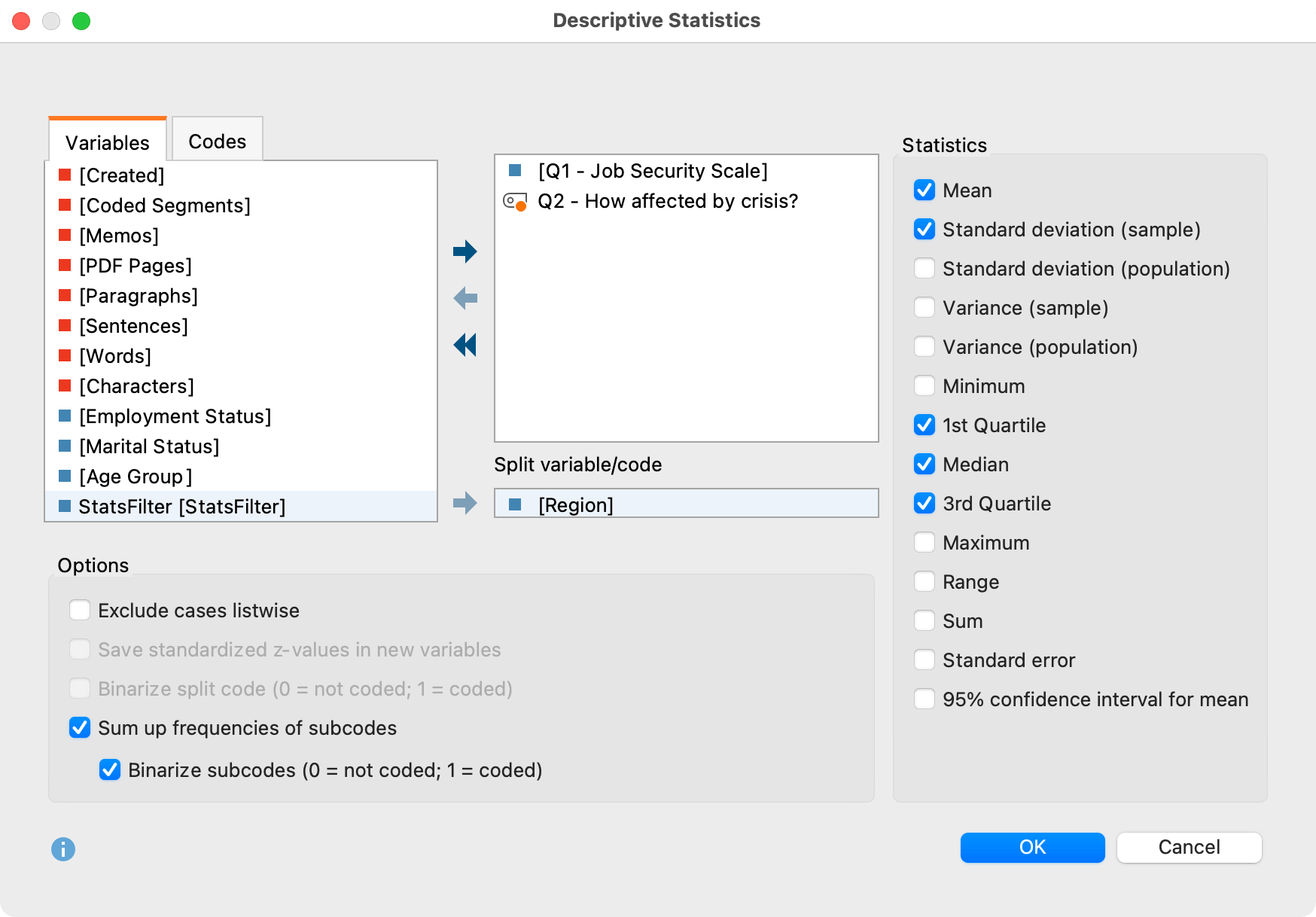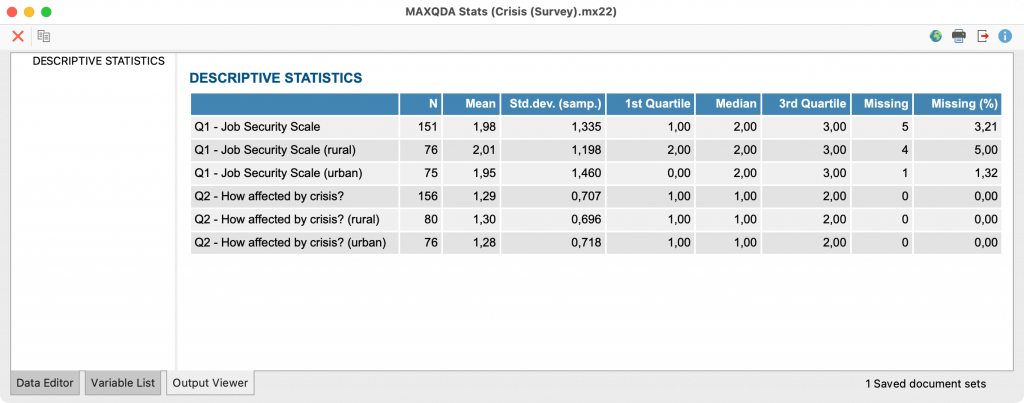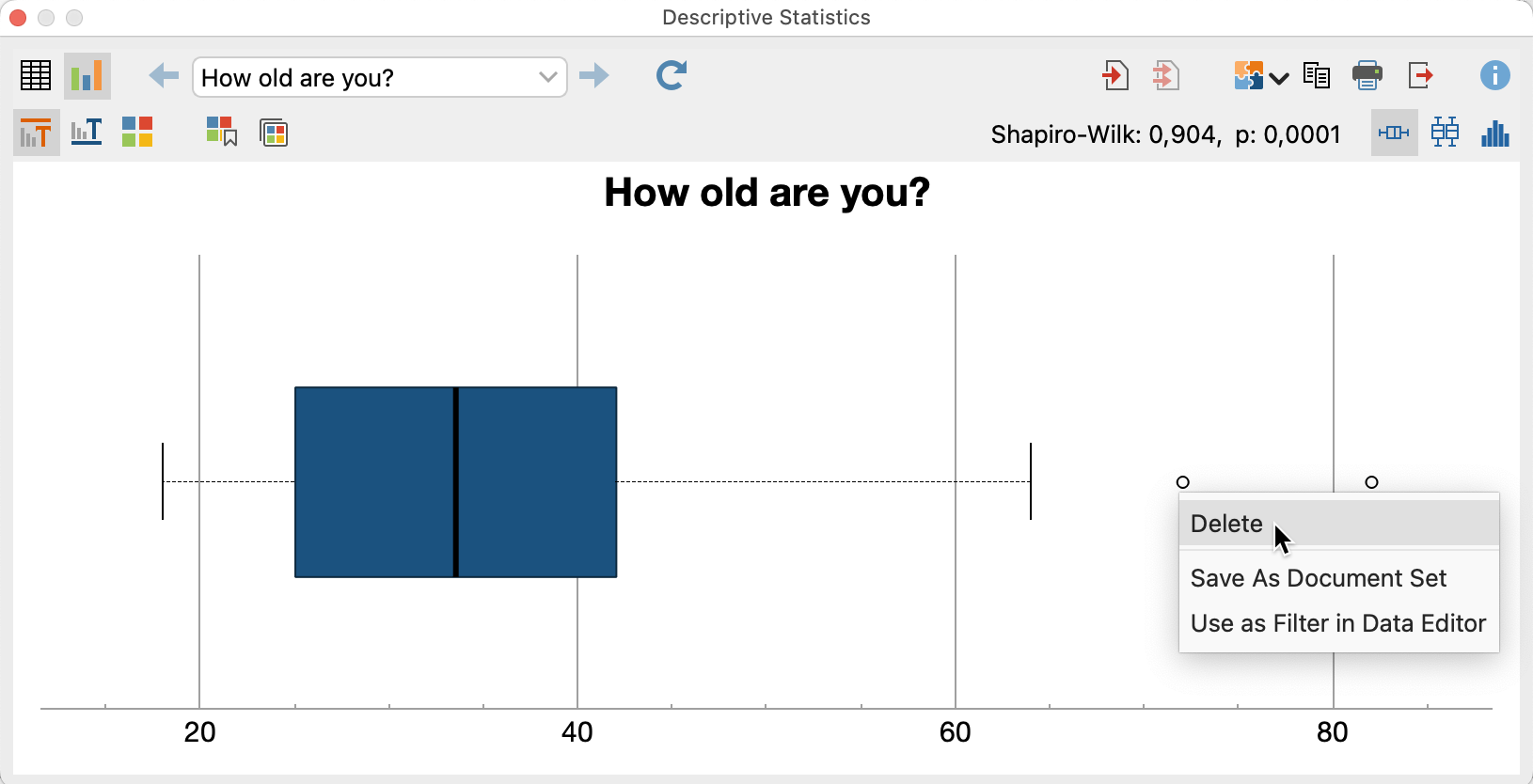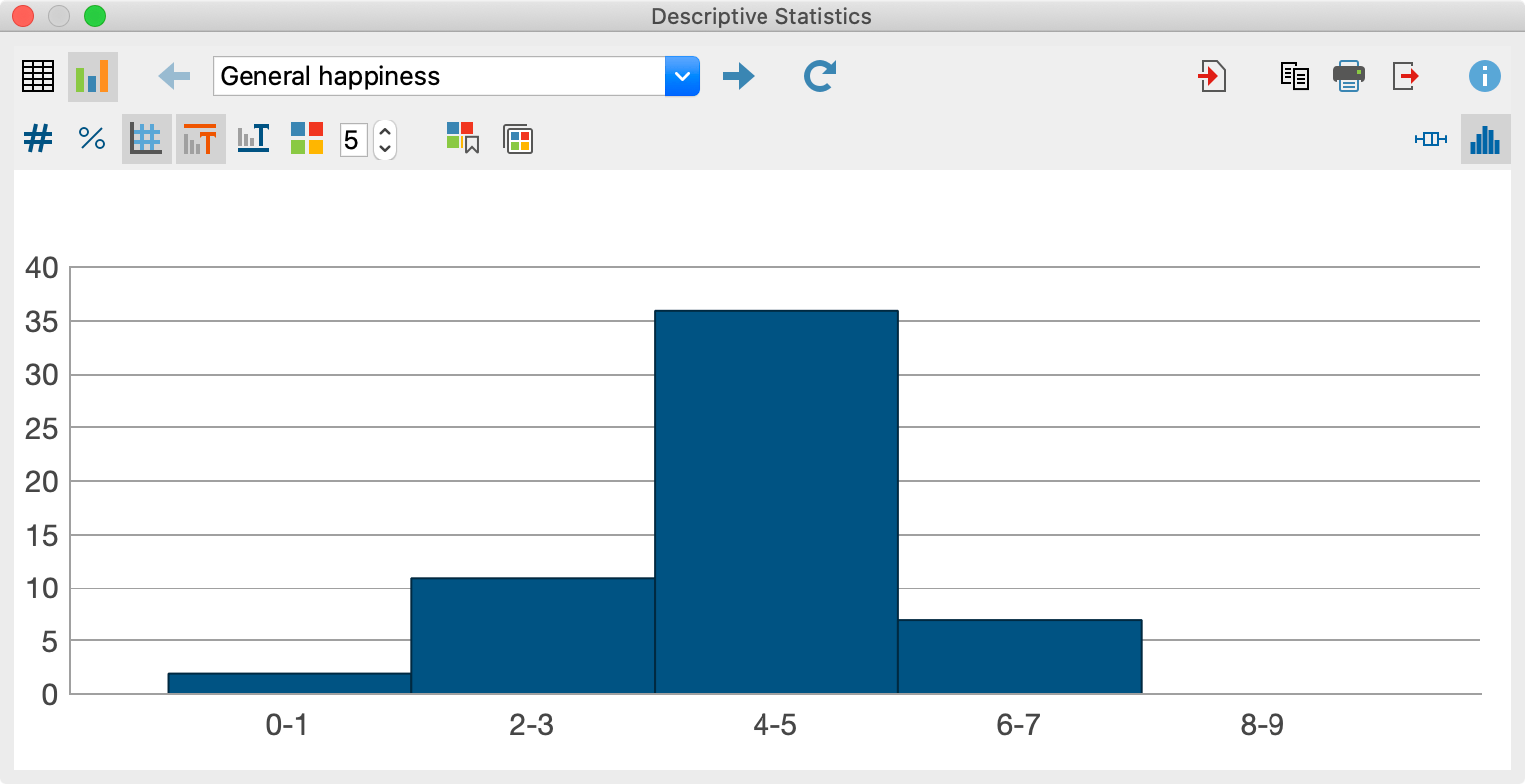With MAXQDA Stats you can calculate various measures of descriptive statistics for several variables and codes simultaneously, and you can compare results in an easy-to-read table. Begin the evaluation using the Descriptive Statistic > Descriptive Statistics menu. The following window will appear, where you can select all the desired variables and codes. In the window, only integer or decimal variables will be displayed:

Variables can be selected in several ways:
- Double-click on a variable.
- Drag and drop the variable into the right window pane.
- Select one or multiple variables with the mouse by holding the Ctrl/Cmd key then drag the selection into the right window pane with the mouse, or click the blue arrow in the middle of the window.
To generate descriptive statistics for code frequencies per document, switch to the “Codes” tab and select the desired codes. (This option is available only if MAXQDA Stats was launched with the data of a MAXQDA project).
If you want the output to be separated by groups, you can drag a variable or a code into the Split by variable/code field. MAXQDA will then calculate the descriptive statistics for the entire group as well as for each individual subgroup.
In the right pane of the window you can select typical metrics and values for the descriptive statistics, some of which require further explanation:
1st and 3rd Quartile – The first quartile corresponds to the 25th percentile and indicates the value below which 25 % of all values fall. Accordingly, 25% of all values are greater than the value of the third quartile, that is the 75th percentile. There are various methods to determine the percentile of a distribution of measured values. A review of nine different methods can be found in Hyndman & Fan (1996): “Sample quantiles in statistical packages”. In MAXQDA Stats method no. 7 is implemented, which is also the default method used by “r”.
Standard deviation (sample) vs. (population) – for the standard deviation of population the unbiased estimator is calculated by dividing the sum of squares by (n - 1), while selecting “sample” the sum is divided by n. The same applies to the calculation of the variance.
Mean error – the standard error of the mean value is output, which is estimated from the random sample. When several samples are taken from a population, the means of these samples scatter around the true mean of the population. This scattering is called mean error.
95% confidence interval for mean – Using the mean error, the limits of the interval are calculated and displayed, which represent a 95% probability of the population mean.
In the lower section of the window, the following options are available:
Exclude cases listwise – select this option to include only cases for which all selected variables have a valid value.
Save standardized z-values in new variables – Check this option to perform a z-standardization of values for all selected variables and codes, and store the results in the new variables. The original variable name is used, supplemented by the suffix "_zvalues”. Existing variable labels are also used and supplemented by the suffix (z-standardized). If no variable label was present, the variable name is entered as a label.
If you have selected at least one code, you can specify additional options below:
Binarize split code – The splitting of the results is done in two groups; on the one hand for the documents where the splitting code was assigned at least once and on the other hand for the documents where the code does not occur.
Sum up frequencies of subcodes – For parent codes, the frequencies of all subcodes available in the Stats dialogue are added to the code frequency. If the option Binarize subcodes is also selected, the summation only takes into account whether the code was assigned to a document (the frequency of a subcode is set to “1”) or not (the frequency of a subcode is set to “0”). When combining both options, the sum of the subcodes indicates how many subcodes were coded for a document.
Results table
After beginning the evaluation by clicking OK the following results table appears, in which the selected variables and codes form the rows and the selected measures form the columns:

The results table always contains the column “N” with the number of valid cases (far left) and the column “Missing” and “Missing (%)” (far right), which provide information on the absolute and relative proportion of missing values for each variable.
Sort tables and customize columns
Tables can be sorted by clicking a column header, in ascending order with the first click and descending order with the second. Clicking again will restore the original order.
Column widths can be adjusted with the mouse, and their position can be changed by clicking the column header then dragging them to the desired location with the mouse.
Delete rows (variables or codes)
The results table is interactive and one or more rows (variables) can be removed. Right-click a row and select Delete. You can also select multiple rows to delete by holding down the Ctrl/⌘ key. When a variable is deleted from the table the table will not be recalculated, even if the Exclude cases listwise option was selected and the number of the valid values would change.
Transfer results table to the Output Viewer
Once the tables have been created and adapted according to your needs, they can be transferred to the Output Viewer by clicking the Insert into Output Viewer ![]() icon, which allows the tables to later be exported along with other results.
icon, which allows the tables to later be exported along with other results.

Transfer results to Questions – Themes – Theories
In the Questions – Themes – Theories window, you can collect and comment on all the important results of your project. Click the ![]() Send to QTT Worksheet icon in the upper right corner to save the current view in a new or existing worksheet.
Send to QTT Worksheet icon in the upper right corner to save the current view in a new or existing worksheet.
Once you close MAXQDA Stats, you can access all your QTT worksheets via Analysis > Questions – Themes – Theories.
Export and print results table
Several options for exporting and printing the currently displayed results table are available using the following symbols:
![]() Copy – copies the entire table or selection to the clipboard, for example in order to paste it directly into Word.
Copy – copies the entire table or selection to the clipboard, for example in order to paste it directly into Word.
![]() Print – starts the print process and displays a print preview, in which the settings such as margins, orientation, headers and footers can be applied.
Print – starts the print process and displays a print preview, in which the settings such as margins, orientation, headers and footers can be applied.
![]() Export – exports the table in Excel format, website (HTML) format or RTF format for Word and other word processing programs.
Export – exports the table in Excel format, website (HTML) format or RTF format for Word and other word processing programs.
Display results as a box plot or histogram
You can display the distribution of an evaluated variable or code as a box plot or histogram. Using the symbols ![]() and
and ![]() you can switch between the chart view and the table view. As soon as the chart is visible, you can choose between box plot and histogram.
you can switch between the chart view and the table view. As soon as the chart is visible, you can choose between box plot and histogram.
In the boxplot as well as in the histogram, the result of a Shapiro-Wilk test for normal distribution is displayed in the upper right corner.

The box plot is generated according to the following rules:
- The vertical line in the box indicates the median.
- The boundaries of the box correspond to the 1st and 3rd quartiles.
- The arms ("whiskers") reach up to the highest or lowest data value, which is a maximum of 1.5 interquartile distances from the edges of the box.
- All data outside the whiskers are marked with a circle as an outlier.
The boxplot is interactive:
- If you hold the mouse pointer over an outlier (that is, a circle), the case number and the case’s value for the variable or code are displayed.
- If you right-click on an outlier, a context menu appears with the following options: (1) remove the case from the graph and the calculation, (2) filter the Data Editor so that only this case is displayed, and – if you are working with a MAXQDA project – save the case in a document set for MAXQDA.
You can change the display from a ![]() box plot to a
box plot to a ![]() histogram by clicking on the corresponding icons in the upper right-hand corner:
histogram by clicking on the corresponding icons in the upper right-hand corner:

MAXQDA calculates the initial number of classes used according to the Rice Rule: Round up (2n^(1/3)). For integer variables, empty classes may not be displayed at the end of the distribution. You can adjust the number of classes for the currently displayed histogram at any time in the number field above the chart.
You can use the icons in the toolbar above the chart to display or hide titles and subtitles and to set the color. With histograms, the data label above the columns can also be switched on and changed from absolute to relative values.
The size of the diagram automatically adjusts to the window size. Enlarge the window to obtain a larger diagram.
Exporting charts
Box plots and histograms can be transferred to the Output Viewer for storage and later export, or they can be transferred to a QTT worksheet. To do this, click on the corresponding icons in the top right corner of the toolbar:
![]() Insert into Output Viewer and
Insert into Output Viewer and ![]() Send to QTT Worksheet.
Send to QTT Worksheet.
To export or print a chart directly, the usual symbols are available in the upper right-hand corner of the window:
![]() Copy,
Copy, ![]() Print,
Print, ![]() Export.
Export.
